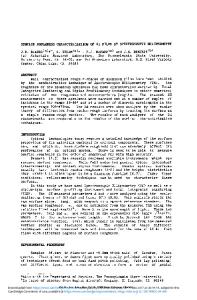Optical Indices of Hydride of Mg-Ca Alloy Thin Films Evaluated by Spectroscopic Ellipsometry
- PDF / 430,435 Bytes
- 5 Pages / 612 x 792 pts (letter) Page_size
- 79 Downloads / 335 Views
Optical Indices of Hydride of Mg-Ca Alloy Thin Films Evaluated by Spectroscopic Ellipsometry Y. Yamada1, K. Tajima1, M. Okada1, M. Tazawa1, A. Roos2, and K. Yoshimura1 1 National Institute of Advanced Industrial Science and Technology (AIST), Anagahora 2266-98, Shimoshidami, Moriyama-ku, Nagoya 463-8560, Japan 2 Department of Engineering Sciences, The Ångström Laboratory, Uppsala University, 751 21 Uppsala, Sweden ABSTRACT Mg1-zCaz (0.03 < z < 0.17) alloy thin films covered with thin Pd are hydrogenated using 4% H2 in Ar under atmospheric pressure at room temperature. The optical indices, which are refractive indices and extinction coefficients, in the wavelength between 250 and 1700 nm of these hydrides were evaluated with spectroscopic ellipsometry. The evaluated refractive indices were about 2.0 for all hydrides, while the extinction coefficients showed the values less than 0.06 in the visible range for hydride with Ca composition of z ≤ 0.08 and the coefficients increased sharply to more than 0.3 with Ca composition z > 0.08. INTRODUCTION Metal hydride switchable mirrors based on Mg-Ca alloys (Mg1-zCaz) have shown excellent optical switching between reflective and transparent states by alternately exposing the mirror to hydrogen and oxygen gas. The visible transmittance in the transparent state of the switchable mirrors increased with Ca composition z and after reaching a maximum of ~50% at z ~ 0.06, the transmittance decreased gradually with increasing Ca composition [1]. Furthermore, optical transmittance spectra in the transparent state of the mirrors with z ≤ 0.08 were fairly flat in the visible range and their color looked completely neutral [1]. These high visible transmittance and achromatic properties can improve the weak points of the switchable mirrors based on Mg-Ni with a pale yellow color appearance [2] and Mg-Ti alloys with low transmittance in their transparent states [3]. In this paper, we have evaluated the optical indices of Mg-Ca alloy hydride thin films in the wavelength between 250 and 1700 nm with spectroscopic ellipsometry and we have compared with those of Mg-Ni and Mg-Ti hydride thin films. EXPERIMENT Mg-Ca alloy thin films of ~ 80 nm thickness were prepared on quartz substrates using direct-current (dc) magnetron co-sputtering of Mg (99.99%) and Ca (99.5%) metal targets under unheated condition. These thin films were subsequently covered with a thin Pd film of ~ 7.5 nm thickness sputtered with a Pd (99.99%) metal target without breaking the vacuum. The Pd film plays a role as a catalyst to take in hydrogen gas as well as protecting the Mg alloy layer from oxidation. The base pressure of the vacuum chamber was less than 1 × 10-5 Pa and the working pressure during deposition was kept at 0.3 Pa using a mass-flow controller of Ar. The
composition of the alloys was controlled by adjusting the sputtering power to Mg and Ca targets. The composition was confirmed with Rutherford backscattering spectroscopy measurements using films deposited on glassy carbon substrates. Optical indices of Mg-C
Data Loading...









